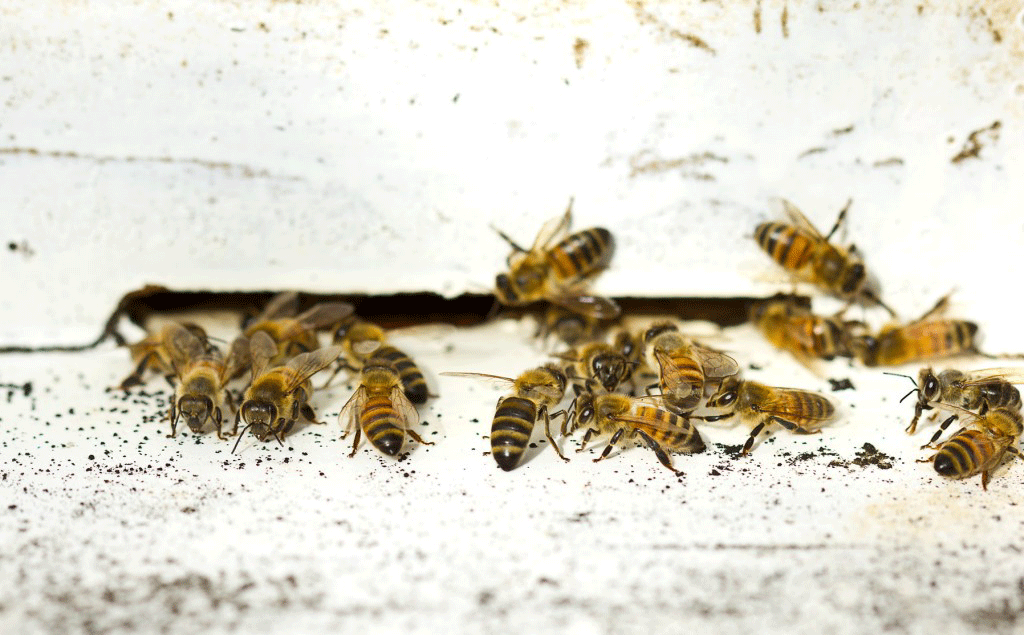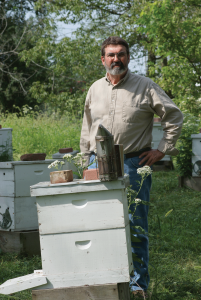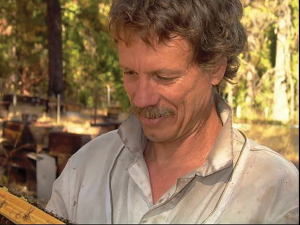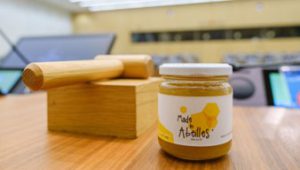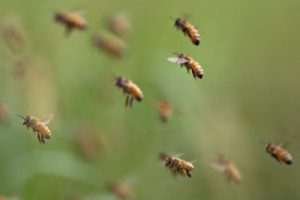ALL ABOUT LABELS
By Michele Colopy
Beekeepers tend to be an experimental lot.
Label directions provide valuable information. Label directions protect us, our honey bees, and our environment. There is a direct correlation between properly following label directions and the health of our bees. The application of pesticides in and around the hive, along with other products beekeepers use to support the health of their honey bees requires vigilance. Products can become problematic if the label directions are not followed. Synergisms can be unexpected, but created when products are used in tandem, mixed together, or in-hive products are miss-applied, including use of expired products. The label will clearly state the expiration date of the product. Beekeepers have a choice of using an expired product or not; your bees are at your mercy. Beekeepers do not realize what “new product” they are creating when they combine “great grandpa’s age old fall treatment for bees” with Terramycin, and another in-hive treatment. Even if “great grandpa’s age old Fall treatment for bees” is comprised of “naturally occurring” elements, it could still cause unhealthy synergisms with the other products or cause those products to fail completely. I interviewed a number of manufacturers of in-hive products regarding concerns of product label comprehension, possible synergisms created when directions are not followed, and their experiences with the real-world use of their in-hive products.
Kathleen Ireland of Mite Away Quick Strips® (MAQS® Beehive Strips) made by NOD
 Mite Away Quick Strips® are Formic Acid polysaccharide gel strips for the treatment of honey bees infested with Varroa mites. When Mite Away Quick Strips (MAQS® Beehive Strips) are placed in the brood chamber of a honey bee hive they act as an organic miticide that kills the Varroa mite where it reproduces, under the brood cap. MAQS® technology eliminates the risk of residues as beekeepers can use it safely during the honey flow.
Mite Away Quick Strips® are Formic Acid polysaccharide gel strips for the treatment of honey bees infested with Varroa mites. When Mite Away Quick Strips (MAQS® Beehive Strips) are placed in the brood chamber of a honey bee hive they act as an organic miticide that kills the Varroa mite where it reproduces, under the brood cap. MAQS® technology eliminates the risk of residues as beekeepers can use it safely during the honey flow.
MAQS® is a brood treatment. Frequently, monitor mite levels and when local thresholds are met, treat colonies during the population increase, peak, and decrease phases. Target the periods when mite levels increase and overtake colonies. As is captured in our registered EPA product labelling, special conditions to follow at the time of treatment are: proper application (two strips for seven days or one strip applied on Day+0 and again on Day+14 for 21 days total), temperature (50-85°F during the first three days), hive strength (minimum of six frames of bees, with a mite count), configuration (standard Langstroth or equivalent) and ventilation (minimum entrance 1.3 cm or ½” full width of the hive). Taking all of these conditions into account are key to a successful treatment.
At NOD we value input from our customers. Based on our customer interactions and data analysis we can make clear, concise decisions to change product labelling, or investigate new research and development opportunities. From this process we can advise that the only adverse events reported to us always include an element of off-label use. The most common issue involves the removal of the Mite Away Quick Strips® outer paper wrap, which acts as a slow release wick. Most beekeepers are upfront when contacting us, notifying us that they didn’t read the instructions until after they had already applied the product. The other top inquiries or concerns come from beekeepers who are observing the cleansing affect that Formic Acid has on sick and weak bees. Typically, they are concerned that this is abnormal or something is wrong with the dosage. We take the time to help beekeepers understand the life cycle of the Varroa mite and its effect on the honey bee immune system; specifically how mites expose bees to viruses and disease. MAQS® will highlight weakness in a colony and cull sick bees. Results post treatment include healthy, prolific brood build-up for honey flows and winter clustering. It is normal to observe around one to two cups of dead bees within the first 72 hours of the treatment.
NOD has changed the label directions since Mite Away Quick Strips® was approved in 2011. The first change referenced the need for more detailed information on entrances and ventilation, all of which was conveyed to us by many loyal commercial users. When the outer paper wrap removal was trending, we immediately approached EPA with a change to include a warning on the label; “DO NOT REMOVE OUTER PAPER WRAPS.” Dosage additions were implemented in 2014, and our next step is to further clarify the dosing based on recent user requests. As part of our due-diligence, we monitor acceptance and concerns regarding label directions, and take the appropriate steps to enhance the consumers’ experience with our products. View NOD’s Proper Application videos that reflect the EPA registered labelling on Youtube at Nod Apiary.
MAQS® is available globally, therefore we collect a variety of data on how beekeepers use it and interpret the label directions. NOD markets Mite Away Quick Strips® as a bio-pesticide in Canada, New Zealand, and the USA. MAQS® Beehive Strips is marketed as a Veterinary Medicine in Bulgaria, Cyprus, Estonia, France, Germany, Greece, Hungary, Ireland, Italy, Latvia, Lithuania, Malta, Portugal, Romania, Slovenia, Spain, Switzerland, and the United Kingdom. MAQS® is sold in 21 different countries and 14 different languages, so it is up to us, the manufacturer to adapt to an ever changing global environment, and focus on making sure the consumers are experiencing the product as intended. The differences in real-world use of our product between U.S. beekeepers and beekeepers in other countries is a really interesting one. The U.S. isn’t alone in their lack of enthusiasm to read labels, and there are many variables that can compound and create major issues. First and foremost is the absence of attention to hives, (i.e. no monitoring for mites or overall health). The next, is applying mite treatments without reading the label or doing any research. Then the cycle repeats itself. In New Zealand most beekeepers treat prophylactically in Spring and Fall, and monitor post treatment (checking for synthetic resistance concerns). Their proactive approach to IPM makes for a more successful program with better results nationally.
In-hive products are best used as a management tool rather than a reactionary tool. Monitor mite levels monthly during the active beekeeping season, and treat when thresholds for your area are reached. Prevent Varroa transmitted viruses from overwhelming your colonies. Highly infested colonies have weakened queens and bees and may require more than one treatment if they can be saved at all. Bees are healthier and more productive when mite levels remain low, have access to good feed and forage, and are protected during winter.
Earl and Carol Hoffman of Strong Microbials, Inc.
 Over the last four years we have worked with scientists researching, field testing and evaluating several “Direct Fed Microbial” (DFM) in-hive microbial supplemental products. Some of them are currently in Beta testing and are not currently available for retail sales. Two of the current products that are being sold retail by distributors are Total Nutrition (TN) and Super DFM honeybee (S DFM HB). Both of these products are U.S. Food and Drug Administration (FDA) approved as Generally Recognized As Safe (GRAS) ingredients per our Material Safety Data Sheet (MSDS) records. The product contains “live concentrated Lactobacillus” bacteria.
Over the last four years we have worked with scientists researching, field testing and evaluating several “Direct Fed Microbial” (DFM) in-hive microbial supplemental products. Some of them are currently in Beta testing and are not currently available for retail sales. Two of the current products that are being sold retail by distributors are Total Nutrition (TN) and Super DFM honeybee (S DFM HB). Both of these products are U.S. Food and Drug Administration (FDA) approved as Generally Recognized As Safe (GRAS) ingredients per our Material Safety Data Sheet (MSDS) records. The product contains “live concentrated Lactobacillus” bacteria.
Per the U.S. Food and Drug Administration (FDA) approved guidelines; microbial (DFM) products are able to state “microbials promote intestinal wellbeing.” NO references to curing diseases or other claims for health improvement are allowed. Our Total Nutrition (TN) product has amino acids (proteins), fatty acids and lipids that help maintain colony strength by boosting hive populations, which results in better crop pollination and honey crops. From a purely microbial reference; Lactobacillus Bacteria (LAB) suppresses pathogens using anti-microbial substances, like peptides. This effect has been clearly demonstrated in the laboratory. Last, DFM is safe to use at all times including during the honey flow!
Because many of the DFM are anaerobic (require low oxygen environments) they must be applied in the DRY state. DFM Microbials should never be applied during antimicrobial treatments such as with Tylosin, and Fumagilin. Microbials should be applied directly to the target audience (nurse bees) in the brood chamber, dusted on the frame top bars. Do not mix the microbials (DFM) into pollen patties or add to sugar water/bee feed. Agricultural Bellows style dusters are the quickest method to apply microbials (DFM) to hives without opening the hive lid.
Super DFM Honeybee (S DFM HB) is currently set at 10 grams per hive application. This is about one (1) tablespoon of microbials (DFM). The directions suggest adding the DFM to a carrier to aid in applying the product. Customers have had concerns measuring the correct amount of carrier to the microbial (DFM) product. Since a carrier like powdered sugar is not required for the microbial (DFM) to have efficacy, some customers have forgone this step.
To correct that error state, the other DFM product called Total Nutrition (TN) is premixed and the directions call for ¼ cup to be directly applied to the nurse bees in the brood chamber super. Agricultural Bellows style dusters may under or over apply the desired amount of microbial (DFM) per hive. Neither of these conditions is detrimental to the hive.
Strong Microbials Inc. continually evaluates how customers interact with microbial (DFM) products. We have added the guidance that cold storage extends shelf life, and we have used all caps for the word “dry” (DRY). Based on microbial data and analysis we have updated and changed the cadence (frequency) that microbial supplementation should be applied. Strong Microbials Inc. does sell direct fed microbials (DFM) globally, and beekeepers from other countries have not misinterpreted the English version of the directions. No difference has been detected in worldwide use of Direct Fed Microbials (DFM) products based on our label directions, and real-world use. “Feed DRY” is understood as “feed DRY” no matter the country.
The best practice for beekeeping management is to be proactive and engage with your hives to provide the best conditions and care that you (the beekeeper) can give.
Phil Craft for Apivar made by Veto-pharma.
Phil serves as the United States technical adviser for Veto-pharma, a French pharmaceutical company, who developed the product, Apivar, to control Varroa. Varroa mites continue to be the greatest challenge to beekeepers today. Apivar is an amitraz based product. The specially designed polymer strip of Apivar slowly releases amitraz to kill up to 99% of the mites in a six-week period, enough time to cover several successive generations of Varroa mites. Apivar strips can be used year round when honey supers are not on the hive, but most beekeepers use them in the Spring, prior to placing honey supers, or later in the year, after supers are removed. Three points should be followed to ensure the best efficacy of treatment:
• Proper dosage: The recommended dosage is two strips per deep brood box full of bees. One strip is placed in the brood boxes for every five frames that are covered with honey bees, or two strips in each brood box if they are full of bees. A strong two story hive will require four strips for treatment. Effectiveness is not guaranteed with a lower dose, and a higher dose may increase the risk of leaving residues.
Proper placement of the strips: strips need to be in the bee cluster, which is also the brood area of the colony.
Proper duration of treatment: Strips must be left in the hives for six weeks (42 days), and removed within 14 days after the 42 day treatment period.
“Read the label” for complete instructions, though supplemental directions, and additional information is available at www.veto-pharma.com. While the directions on the Apivar label are unchanged for now, we have produced a supplemental “directions for use” pamphlet which contains more detailed directions in order to make the label directions more graphic and easy to read. These can be found at beekeeping conferences where Veto-pharma team is present, and also at our webpage. Beekeepers can also email me at phil.craft@vetopharm.com, and I will email  them a digital printable copy of these directions.
them a digital printable copy of these directions.
What happens when the directions are not followed? With Apivar, beekeepers have sometimes failed to use a sufficient number of strips, sometimes only inserting one strip in a brood box full of bees, or failing to put strips into both brood boxes. Undertreating colonies with any miticide will likely result in a failure to control Varroa. Beekeepers should also remember to leave the strips in the hives for the full 42 days (six weeks), Apivar is a slow release product, and the full six weeks of treatment is essential.
Apivar is available in more than 20 countries around the world. The common issue between all countries is beekeeper failure to follow directions with respect to the duration of the treatment, especially by leaving strips in the hive after the end of treatment. We believe that is because beekeepers know Apivar and know that the product did not affect bees or brood and leaves no significant residues in honey. Though there is no evidence of mite resistance for amitraz after 15 years of continued use, we believe that leaving the strips in the hive after the end of the treatment is a dangerous practice in a long term and should be avoided.
Comparing application practices of the product in the U.S. and other countries we have found, “Failure to use the proper dosage is more current in the U.S. compared to other countries.” Also, new Apivar customers tend to be concerned about the visual effect of a slow released treatment. Most of the currently available Varroa products are short-acting treatments that deliver an immediate ‘knock-down’ effect in which many adult mites are killed quickly. A quick kill may look impressive, but most of these treatments only kill phoretic mites (the mites on the bees) and the next generation of mites can quickly re-infest the colony. With a slow release action, Apivar will kill mites during the six weeks treatment, and it’s normal to see less mites fall in the beginning of treatment compared to a knock-down treatment. Be aware about this is very important because some beekeepers consider stopping the treatment before the six weeks, thinking that it will not be effective. Results of Apivar treatment will be seen after the full six-week treatment period. In other countries, where Apivar is present for a longer time, beekeepers are aware of this and beekeepers outside of the U.S. have excellent results in efficacy and Winter survival, they don’t have doubts about it anymore.
Knowing what is going on in your hive is the basic hive management issue that I stress to beekeepers. Beekeepers are aware of this from my “Ask Phil” question & answer column in Bee Culture, and from my beekeeping talks throughout the country. Good beekeeping management is not calendar driven, though like all farmers we use the calendar as a guide. With Varroa monitoring we learn what Varroa mite infestations are like prior to treatment, and after treatment results are essential as well, for determining the effectiveness of our treatment. While we may use the calendar as a guide for determining the best time of the year to treat for Varroa, monitoring can determine the urgency for treatment, or may tell us we can wait and treat at a later time.
Randy Oliver-Understand how the products work and follow the label
Quality products will post their studies and data on the manufacturer’s website. Beekeepers should understand how the products work, and review the manufacturer’s studies, as well as independent research; “a single study means little.” “Thoroughly reading and understanding the label on any product should be the starting point for every beekeeper. A number of bee products are sold in countries in addition to the U.S. There is often a great deal of good information on the testing of those products from Canada, New Zealand, Australia, and the E.U.” “For most (but not all) products, details of application method for best efficacy will be on the label. That said, beekeepers tend to be an experimental lot, and often experiment to cut corners or figure out ways to improve efficacy. They should be aware that if their methods fall outside the restrictions on the label, that they will be in violation of federal law.”
“Some products may interact with other products, or with management practices (such as the feeding or transporting of hives). Miticides (or their residues) may well interact with agricultural chemicals or other residues in the combs. Look to the label, but there is no way for the manufacturer to test every conceivable possibility. In general, the application of many products causes some degree of stress to the colony – avoid adding additional stressors during the period of application. Ask the manufacturer if they have field test data on potential interactions.”
“Manufacturers may change their label from time to time to update it in response to new findings (such as temperature limitation adjustments, required protective gear, restrictions if honey supers are on, etc.). One of the biggest mistakes is for a beekeeper to try a new product for the first time on all of his or her hives. There is often a learning curve involved with a product – I suggest asking other beekeepers in your locale for their experience, and testing a product on only a portion of your hives the first time.”
Michele Colopy is the Program Director for the Pollinator Stewardship Council. She holds a Master’s degree in Arts Administration/Nonprofit Management from The University of Akron, and has created, revitalized and held leadership roles in nonprofit organizations for 20 years.
info@pollinatorstewardship.org




